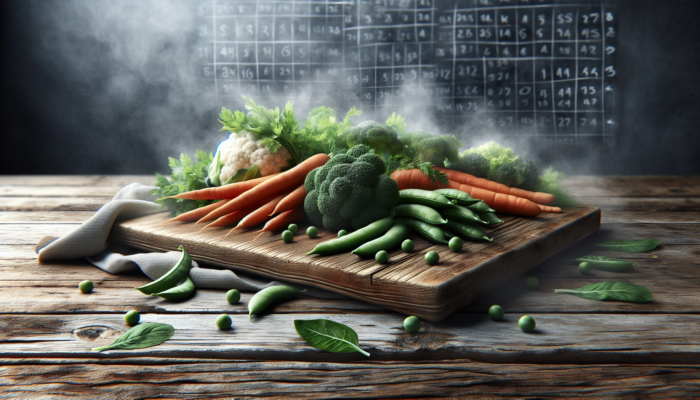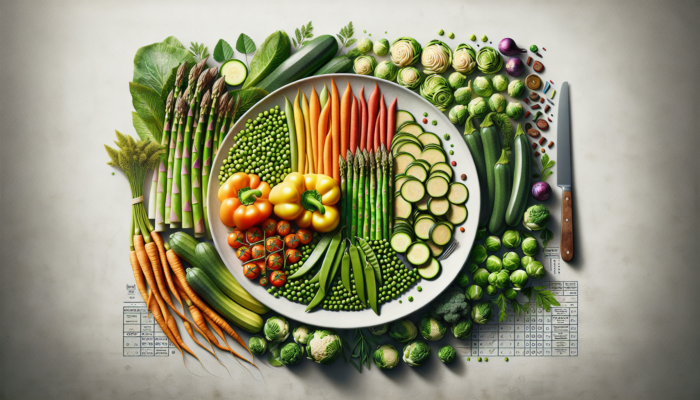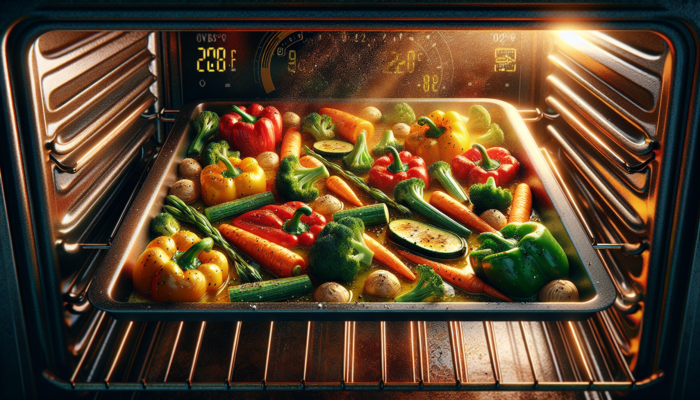Master Your Culinary Skills: Achieve Perfectly Cooked Crisp Vegetables Every Time
Gaining the ability to cook vegetables to the perfect level of doneness without creating a mushy texture is a fundamental skill in the culinary arts. This skill requires a blend of precise cooking techniques, accurate timing, and the right kitchen tools to achieve that sought-after delightful crunch. To master this essential culinary art, one must develop an understanding of the individual characteristics of various vegetables, discover the most effective cooking methods, and learn how to adjust cooking conditions skillfully. This comprehensive guide will immerse you in the fascinating world of vegetables, providing you with the crucial knowledge and techniques necessary to prepare them while preserving their crisp texture and enhancing their flavors.
Choosing the Right Vegetables for Maximum Crispness During Cooking

The foundation of achieving the desired crunch in your culinary creations begins with selecting the most suitable vegetables. It’s essential to know that not all vegetables possess the same resilience; understanding which varieties hold up better under various cooking methods can significantly influence the overall success of your dishes. By making informed choices when selecting vegetables, you’ll be setting the stage for culinary success.
Identify the Best Vegetables for Sustaining Their Crunchy Texture
Some vegetables are inherently better at retaining their crunchiness than others. For instance, carrots, broccoli, and snap peas are renowned for their ability to maintain a firm texture when cooked correctly. These vegetables are packed with high water content and possess the structural integrity needed to endure heat without succumbing to mushiness. In contrast, softer vegetables like zucchini and eggplant can quickly lose their firmness if not handled with care. By understanding which vegetables are more robust, you can elevate your culinary skills and make better cooking decisions.
Crucial Tips for Selecting Fresh Vegetables for Optimal Cooking Performance
The freshness of your vegetables is paramount for maintaining their texture as they cook. When shopping, look for vegetables that boast vibrant colors, a firm feel when touched, and are free from blemishes or soft spots. For example, green beans should deliver a satisfying snap when bent, while brussels sprouts should feel dense and compact. Consider visiting local farmers' markets or organic grocery stores for a fresher selection, as these often provide superior quality compared to conventional supermarkets. This approach greatly increases your chances of achieving that ideal crunch in your dishes.
Explore Seasonal Vegetable Varieties That Maintain Their Texture When Cooked

The seasonality of vegetables greatly influences their quality, flavor profile, and overall cooking experience. During spring, choose asparagus and peas, both of which preserve their texture beautifully when prepared with care. Summer brings a bounty of bell peppers and corn, while autumn showcases hearty options like cauliflower and carrots. Cooking with seasonal produce not only enhances the flavor profile of your meals but also ensures you are utilizing vegetables at their freshest and most flavorful.
Effective Cooking Techniques to Prevent Vegetables from Becoming Mushy
The cooking methods you employ play a significant role in determining the final texture of your vegetables. Certain techniques excel in preserving their original texture, ensuring that they remain crisp and enjoyable to eat, while others can lead to undesirable softness and mushiness.
Steaming: A Gentle Cooking Method That Preserves Vegetable Quality
Steaming is a remarkably effective technique for cooking vegetables while preserving their crunch. This gentle cooking method uses steam to prepare the vegetables, allowing them to retain both their vibrant color and texture. The secret to successful steaming lies in precise timing—oversteaming can lead to that dreaded mushy outcome. Aim for a steaming duration of approximately 4-7 minutes for most vegetables, checking for doneness frequently. Employing a steaming basket can facilitate even cooking, resulting in a colorful and nutrient-rich dish that will impress your dining companions.
Roasting Vegetables: Elevate Flavor While Retaining Texture

Roasting is another exceptional cooking method that yields vegetables free from mushiness while enhancing their natural flavors. The high, dry heat of the oven caramelizes the natural sugars found in vegetables, intensifying their flavors while keeping them firm and crisp. Preheat your oven to a high temperature, around 220°C (425°F), and cut your vegetables into uniform pieces for even cooking. Lightly toss the vegetables in a small amount of olive oil, season with salt and pepper, and roast them until they are tender yet still crisp—typically around 20-30 minutes.
Quick Sautéing Techniques for Perfectly Crisp Vegetables
Sautéing is a rapid cooking method that can yield perfectly crisp vegetables when executed correctly. The secret lies in using a hot pan and a minimal amount of oil to sear the vegetables quickly. Begin by heating your pan until it’s hot, then add the oil followed immediately by your chopped vegetables. Stir frequently and cook for just a few minutes to ensure they retain their vibrant color and crunch. This method is particularly effective for bell peppers, broccoli, and asparagus, making it a go-to technique for quick and healthy meals.
Blanching and Shocking: Preserve Vegetable Crunch with These Techniques
Blanching is an outstanding method for retaining both the color and texture of vegetables. This technique involves quickly boiling the vegetables before plunging them into ice water. The sudden change in temperature halts the cooking process, locking in crunchiness. Blanching works particularly well for vegetables like green beans and broccoli, which can later be sautéed or tossed into salads to add an extra layer of crunch.
Timing and Temperature: Crucial Factors for Maintaining Crisp Vegetables
Understanding the significance of timing and temperature is essential in your endeavor to avoid mushiness in cooked vegetables. Each type of vegetable has an optimal cooking time and temperature range that can greatly impact the final outcome of your dish.
Optimal Cooking Times for Different Vegetable Varieties
Cooking times for vegetables can vary significantly based on their type. For instance, carrots generally require roughly 6-8 minutes to steam, while spinach only needs about 2-3 minutes. Maintaining a handy reference list of cooking times for your favorite vegetables can streamline your meal preparation, ensuring that everything comes together seamlessly without the risk of overcooking.
Control Temperatures for Ideal Cooking of Vegetables
Maintaining control over cooking temperatures is crucial to achieving perfectly cooked vegetables. Cooking at excessively high temperatures can char the exterior while leaving the interior undercooked, resulting in an uneven texture. Conversely, cooking at too low a temperature may lead to limp vegetables that lack the desired crunch. For most stovetop methods, medium-high heat is ideal, while oven roasting typically requires a higher temperature to achieve caramelization without sacrificing texture.
How to Check Vegetable Doneness Without Overcooking
Mastering the skill of checking for doneness without overcooking is essential for any home cook. For most vegetables, a fork or knife should easily pierce through without much resistance, indicating they are cooked yet still maintain their firmness. If you’re uncertain, tasting is a reliable method—remove a piece from the heat and take a quick bite. Remember that vegetables continue to cook even after being taken off the heat, so it’s wise to err on the side of caution to ensure they remain crisp.
Adjusting Cooking Times for Variations in Altitude and Humidity
Both altitude and humidity can significantly influence cooking times. At higher altitudes, water boils at lower temperatures, meaning vegetables may require longer to cook thoroughly. In contrast, in humid environments, vegetables may retain more moisture, necessitating adjustments in cooking times. It’s essential to consider these factors and adapt your cooking methods accordingly to achieve consistent culinary results.
Essential Kitchen Tools for Preserving Vegetable Texture
Equipping yourself with the right kitchen tools can significantly enhance your ability to achieve optimal texture when cooking vegetables. Various gadgets can improve your cooking experience and outcomes, making the process more enjoyable and efficient.
Utilizing Steamers and Racks to Prevent Direct Heat Contact
Steamers are invaluable kitchen tools for cooking vegetables without turning them mushy. They allow for even cooking while preventing vegetables from sitting in water, which can lead to sogginess. Consider investing in a tiered steamer or a bamboo steamer, which can accommodate various types of vegetables simultaneously, saving you time and effort in your cooking routine.
Discover the Advantages of Air Fryers for Cooking Crisp Vegetables
Air fryers have gained immense popularity due to their ability to create crispy textures without the need for excessive oil. These appliances circulate hot air around the food, yielding a crunchy exterior while keeping the interior tender. This method is particularly suited for vegetables like zucchini fries and sweet potato wedges, allowing you to indulge in your favorite dishes without sacrificing health or texture.
Selecting the Right Pots and Pans for Vegetable Cooking
Choosing the right cookware can greatly impact how your vegetables cook. Lightweight pans, such as skillets or sauté pans, heat up quickly and provide even cooking, which is crucial for achieving that desirable crispy texture. Non-stick options can also be beneficial, as they require less oil and make flipping and stirring much easier, which is essential for maintaining the integrity of your vegetables.
Innovative Kitchen Gadgets for Achieving Perfect Vegetable Texture
Apart from the basics, several innovative kitchen tools can help you achieve impeccable vegetable texture. Investing in a mandoline slicer for even cuts or a vegetable peeler that creates ribbons of zucchini or carrots can streamline preparation and ensure uniform cooking, which is vital for preventing mushiness and enhancing presentation.
Flavor and Seasoning Techniques That Preserve Vegetable Texture
After cooking your vegetables to perfection, the next vital step involves effectively seasoning them without compromising their texture. Striking this balance requires a thoughtful approach to flavors and seasoning techniques.
Enhancing Natural Vegetable Flavors Without Overpowering
The key to seasoning vegetables effectively is to amplify their natural flavors without overshadowing them. Begin with a light sprinkle of salt and pepper, allowing the inherent taste of the vegetables to shine. Gradually introduce additional seasonings, tasting as you go, to achieve the right balance that complements without overwhelming their texture and overall appeal.
Incorporating Herbs and Spices While Preserving Crispness
Herbs and spices can elevate your vegetable dishes, but their use should be strategic to avoid overpowering the vegetables. Fresh herbs such as basil or parsley should be added near the end of the cooking process to prevent wilting, while dried spices can be introduced earlier. This approach ensures that the flavors infuse without compromising the vegetables' crispness, creating a harmonious dish.
Selecting Marinades and Dressings That Complement Texture
Marinating vegetables adds depth and flavor, but it’s crucial to apply the right method. Opt for lighter marinades that won’t weigh down the vegetables, such as a simple mixture of olive oil, lemon juice, and herbs. Allow them to marinate briefly before cooking to avoid excessive moisture absorption, which can lead to a mushy texture that detracts from the dish’s overall quality.
Balancing Flavors While Ensuring Vegetable Crunch
Striking a balance between flavors and maintaining texture requires careful thought regarding the ingredients you use. Acidic components, such as vinegar or citrus juice, can brighten your dish without compromising texture. Pair these acidic elements with robust vegetables that can withstand bold flavors, ensuring that each bite remains crunchy and satisfying, ultimately enhancing the dining experience.
Proper Storage Techniques for Vegetables to Ensure Culinary Success
Effective storage is essential for preserving the quality of your vegetables, which ultimately influences their texture during cooking. The manner in which you store vegetables can significantly impact their cooking performance, so it’s crucial to adopt best practices for optimal results.
Best Practices for Storing Fresh Vegetables
To keep your vegetables fresh and crisp, store them in a cool, dry environment, ideally within your refrigerator. Utilize perforated plastic bags or containers to promote airflow, preventing moisture buildup that can lead to wilting. For leafy greens, consider wrapping them in a damp paper towel before placing them in a bag to maintain their crispness and extend their shelf life, allowing you to enjoy them longer.
Storing Cooked Vegetables to Preserve Their Texture
When it comes to storing cooked vegetables, careful attention is necessary to prevent them from becoming mushy. Allow them to cool completely before transferring them to an airtight container. If possible, store them without added moisture or sauces, as these can lead to sogginess. Reheating in a hot pan can help restore some of the texture lost during storage, making them more enjoyable when served.
Freezing Vegetables for Future Use While Maintaining Quality
Freezing vegetables is an excellent strategy for preserving their quality and texture for later use. Briefly blanching vegetables before freezing helps maintain their color and crunch. Use airtight freezer bags or containers, ensuring to remove as much air as possible to prevent freezer burn. When you're ready to use them, cook them directly from the freezer, adjusting cooking times as needed to achieve optimal results.
The Impact of Proper Storage on Vegetable Cooking Performance
The way you store vegetables can profoundly influence their cooking performance. Poor storage conditions can lead to moisture and nutrient loss, resulting in diminished flavors and texture. Understanding best practices for vegetable storage will ensure they remain in optimal condition, ready to be transformed into delightful meals that satisfy your taste buds.
Overcoming Common Challenges in Vegetable Cooking
Even seasoned chefs encounter challenges when preparing vegetables. Knowing how to troubleshoot these common issues can prevent your dish from becoming a culinary disappointment.
Reviving Overcooked Vegetables: Tips and Tricks
Overcooked vegetables often result from cooking at excessively high temperatures or for too long. To remedy this, consider sautéing them briefly in a hot pan with a small amount of oil, which can help restore some texture. Alternatively, overcooked vegetables can be integrated into soups or purees, allowing you to salvage the dish without wasting any ingredients while enhancing the overall flavor profile.
Managing Vegetables That Have Become Too Soft
Soft vegetables can be frustrating, particularly when you aspire for a crunchy texture. If you discover that your vegetables have turned soft, consider roasting them with a sprinkle of breadcrumbs or cheese to introduce some much-needed texture. Alternatively, blending them into a sauce or dip can effectively mask their texture deficiencies while providing a delicious accompaniment to your meal.
Reviving Vegetables That Have Lost Their Crunch: Simple Solutions
If your vegetables have lost their crunch, soaking them in ice water for a few minutes can help restore their texture. After soaking, pat them dry and give them a quick sauté or roast to regain some firmness. This technique works wonders for celery and carrots, making them enjoyable additions to any dish.
Avoiding Common Mistakes in Vegetable Cooking
Steering clear of common pitfalls is crucial for achieving the ideal texture. One significant mistake is overcrowding the pan, which may lead to steaming instead of sautéing. Additionally, overlooking proper seasoning can result in bland flavors. Always taste as you cook and make necessary adjustments to ensure the best culinary outcomes that will impress your guests.
Addressing Frequently Asked Questions About Vegetable Cooking
Which Vegetables Are Best for Retaining Their Texture During Cooking?
Vegetables such as carrots, broccoli, and snap peas are optimal choices for maintaining their texture during cooking. They possess the structural integrity necessary to remain crisp throughout the cooking process, making them ideal for a variety of dishes.
How Can I Prevent My Vegetables from Becoming Mushy?
To avoid mushiness, opt for quick cooking methods such as steaming or sautéing, and ensure you monitor cooking times diligently to prevent overcooking. Always check for doneness at regular intervals to maintain the desired texture.
Is Steaming or Roasting More Effective for Achieving Crispness?
Both methods can yield crisp results; however, roasting enhances flavor through caramelization, while steaming is gentler, preserving the natural texture and color of the vegetables.
What Are the Recommended Cooking Times for Various Vegetables?
Cooking times can vary; for example, green beans take approximately 4-5 minutes to steam, while carrots may require 6-8 minutes. Always check for doneness to avoid overcooking.
How Can I Check If My Vegetables Are Fully Cooked?
You can test for doneness by piercing them with a fork. They should be tender yet firm. Tasting a piece is also an effective method to gauge readiness, ensuring that the texture remains intact.
Can I Store Cooked Vegetables Without Losing Their Texture?
Yes, cooked vegetables can be stored in airtight containers. Allow them to cool completely before sealing, and avoid adding moisture to maintain their texture during storage.
What’s the Best Strategy for Reviving Overcooked Vegetables?
To revive overcooked vegetables, sauté them briefly in a hot pan with oil or incorporate them into soups or sauces for a flavorful solution that enhances your dish.
How Can I Balance Flavors Without Compromising Crunch?
Utilize light seasonings and introduce fresh herbs towards the end of the cooking process. This approach enhances flavor without diminishing the vegetables’ crunch, creating a delightful balance.
What Should I Avoid When Cooking Vegetables?
Avoid overcrowding the pan, overcooking, and neglecting proper seasoning. These mistakes can lead to bland flavors and undesirable textures that detract from your culinary efforts.
Are There Specific Storage Techniques for Keeping Fresh Vegetables?
Store fresh vegetables in a cool, dry place, ideally in the fridge, utilizing perforated bags to allow airflow and prevent moisture buildup that can lead to spoilage.
Connect with us on Facebook for the latest updates!
The post Cooking Vegetables Without Mushiness: Top Techniques Revealed appeared first on https://cookinggods.com
The Article Top Techniques for Cooking Vegetables Without Mushiness Was Found On https://limitsofstrategy.com

